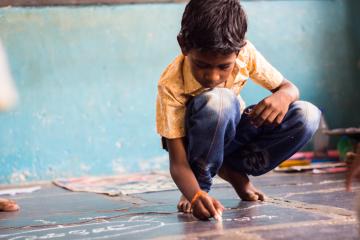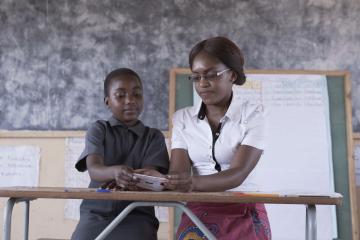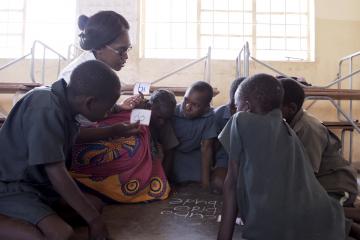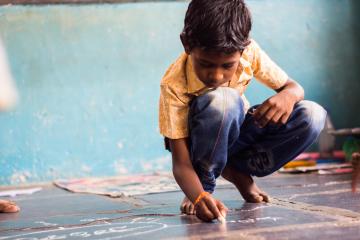
Meeting children where they are can help them catch up in school.

Teaching at the Right Level (TaRL) is a cost-effective approach to boosting learning for millions of children. Evidence from multiple countries shows that TaRL can help children catch up on foundational reading and math, and they make big strides at a low cost—often less than $10 per child per year.
Many governments and school systems can adapt the TaRL approach to help address the learning crisis. Grouping school children by learning level, rather than age or grade, for a part of the day can help children catch up on foundational reading and math skills.
Every year, more than 700 million children attend school—but many do not learn basic reading or math. According to recent estimates, 70 percent of children in low- and middle-income countries cannot read a simple story by age 10. This learning crisis threatens not only individual futures but also overall economic growth. While countries have made great progress expanding access to school, ensuring children actually learn is now the central challenge.
Teaching at the Right Level (TaRL) is an effective approach to build foundational skills in math and reading. Developed by the Indian NGO Pratham, TaRL assesses students, groups them by learning levels, and focuses on foundational skills. Teachers use a simple tool to group the children for part of the day based on their learning levels rather than age or grade. The students are then taught using a range of engaging activities, focusing on foundational skills rather than solely on the curriculum. Their progress is tracked so that they can advance into the next group. This approach has helped children make rapid gains, sometimes achieving in weeks what would otherwise take years.
TaRL has a strong track record of improving foundational learning outcomes. A series of randomized evaluations by J-PAL affiliated researchers over the past fifteen years have shown that TaRL has led to some of the largest learning gains among rigorously evaluated education programs. The iterative process of innovation and evaluation, in collaboration with researchers, helped Pratham, multiple governments, and other partners refine and adapt TaRL over time.
The TaRL approach is improving learning worldwide—and could reach many more children. In India, Pratham has worked with state governments across the country to implement the TaRL approach in classrooms at scale. Based on this success, governments and NGOs across sub-Saharan Africa are adapting and scaling the TaRL approach, with support from partners, including TaRL Africa and Pratham. Now, TaRL has reached more than 80 million children in India and Africa, and there are many millions more children worldwide who still stand to benefit.
Cost and design considerations
Tailoring instruction to learning levels is highly cost-effective. Among 27 studies of programs to improve student learning with cost data analyzed by J-PAL, tailored instruction programs ranked among the most cost-effective. This was true for all programs that aligned instruction with students’ learning levels, regardless of their specific approach (reorganizing classes, training instructors in new methods, and/or integrating technology).
TaRL is most effective when implemented as a comprehensive strategy that shifts the focus of education systems toward actual learning outcomes. A few things help set teachers up for success so that they can dynamically respond to student learning levels. Real progress occurs when teachers are supported with clear objectives, use data to understand students’ learning needs, receive ongoing in-person mentoring, and have opportunities to collaborate and share experiences with peers.
Regular data collection and review, and ensuring consistent adherence to TaRL methodology, is essential to sustaining and scaling gains. Collecting data on student learning regularly, and monitoring adherence to TaRL protocols, makes it easier to see which parts of the TaRL approach are being implemented well and where there is room for improvement.
Tailoring instruction to learning levels is highly cost-effective.
Implementing partners
Implementers bring deep local knowledge, technical expertise, and a commitment to evaluation and learning as they bring these programs to life. Partners include the following key collaborators (listed in alphabetical order).

The role of low- and middle-income governments
Governments worldwide have integrated the TaRL approach into education systems to help children master foundational reading and math skills. As Pratham refined the TaRL programming over time with learnings from rigorous evaluations, it worked closely with local governments in India to pilot and then scale TaRL widely. Pratham has partnered with state governments across India to implement TaRL at scale, reaching more than 76 million students.
Several African governments have also adapted and scaled the TaRL approach with technical support from Pratham, J-PAL, and TaRL Africa. Zambia piloted their “Catch Up” program and then scaled it to schools across the country, Nigeria has implemented TaRL across seven states, and Côte d’Ivoire is expanding the Programme d’Enseignement Ciblé, a TaRL-inspired initiative. Other African countries with government-led TaRL or similar targeted instruction programs include Angola, Botswana, Cameroon, Eritrea, Ghana, Guinea, Kenya, Madagascar, Namibia, Niger, Sierra Leone, Somalia, South Africa, Tanzania, and Uganda. Alongside implementing support from organizations including the Japan International Cooperation Agency (JICA) and Youth Impact, TaRL Africa has reached more than 7 million students. As of 2025, TaRL has reached over 80 million children in India and Africa, demonstrating the power of government-led action to address the learning crisis.
Governments and NGOs in Latin America and the Caribbean are also adapting the TaRL approach to local contexts, with pilot programs and evaluations underway or completed in several countries, including Brazil and Guatemala. While adoption is still in early stages, organizations like Pratham International and its partners are teaming up with regional education ministries to lay the groundwork for scaling. In the Middle East and North Africa, the Moroccan government is collaborating with researchers to evaluate a nation-wide scale-up of a multi-component education reform, which includes a targeted remedial instruction program, inspired by the TaRL approach.
The role of foreign assistance and philanthropy
Foreign assistance and philanthropy play a crucial role in TaRL’s story, from supporting early evaluations to helping adapt the approach for implementation at large scale. Carl Bennet AB, the Government of the Netherlands, ICICI Bank, the International Initiative for Impact Evaluation, the JICA, the Mistra Foundation, the Swedish Research Council, USAID Development Innovation Ventures (DIV), the William and Flora Hewlett Foundation, and the World Bank have all contributed to evaluations that have helped Pratham refine TaRL over the course of more than fifteen years.
With the results of these evaluations proving TaRL’s effectiveness, foreign assistance and other philanthropic donors have helped bring TaRL to scale in countries around the world. For example, after funding from J-PAL, UNICEF, and the British Council supported the initial piloting of TaRL in Zambia, a USAID DIV grant supported the program’s expansion to 1,800 schools. It was then highly leveraged, bringing in new funding from the Government of Zambia as well as other bilateral and philanthropic donors like Co-Impact and UNICEF—all of which led to the government rolling out the program to reach students in all schools across the country.
Based on the success of the Zambian scale-up, this approach has been implemented in other countries to reach more than seven million children in Africa, attracting funding from other donors and partners including Co-Impact, the Gates Foundation, Founders Pledge, JICA, Prevail, and UNICEF.
Discover more from J-PAL
Discover more from other sources
Teaching at the right level: A promising educational approach for Lebanon
World Bank Blogs
Here’s how we can turn this learning crisis around
World Bank Blogs
Inside a Pratham Classroom in Karnataka
Skoll Foundation
Photos:
(1) Students work through a puzzle as part of a curriculum inspired by Teaching at the Right Level in Pemba, Southern Province, Zambia. Credit: Anton Scholtz, J-PAL/Pratham
(2) Grade 8 students participating in TaRL programming taking a test Kurukshetra, Haryana, India. Credit: Shobhiji Mukerji, J-PAL



